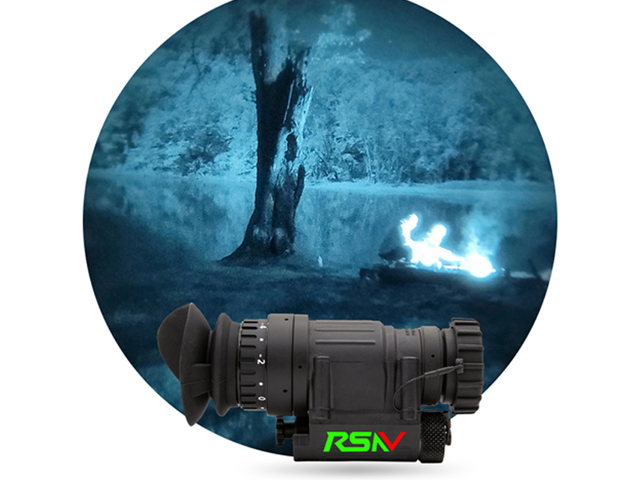HISTORY OF THE PVS-14
Sales Engineer: Grace Gao
Email: grace@bri-elec.com
WhatsApp: 0086-199 2997 5286
A less secret beginning
Although the PVS-14 monocular night vision system may be the standard for today’s technology, where does it come from? The history of this device can actually be traced back to 1939, when the first prototype of an infrared night vision device for anti-tank guns was developed.By 1942, the National Defense Forces had begun developing night vision equipment for the Germans. During World War II, over 300 Panthers were equipped with this equipment, allowing soldiers to have a nighttime view of up to 600 meters. Early devices were not actually much better than searchlights, using infrared filters to transmit near-infrared radiation. In fact, this means that these devices can still provide some lighting and advantages for the enemy.
At the end of the war, Germany developed a “vampire” portable night vision system. Portable is a relative term here - the power pack is the size of a medium-sized backpack, and the infrared illuminator is the size of a child’s head. Nevertheless, it still completed the task and is considered Gen 0 in terms of night vision.
During World War II, Americans were also busy developing night vision technology. The M3 and M1 infrared technology, known as spy sights and sniper sights, played a huge role in the Korean War. After the war, Dr. Vladimir K. Zvorikin of Radio Corporation of America developed a night vision device for the civilian market. However, the size, weight, and high cost of the Gen 0 device are a major obstacle. These devices are clumsy and sensitive to weather conditions - not suitable for the conditions under which they are used.
The first generation device
In the 1960s, there was a significant breakthrough in the first generation of equipment. The AN/PVS-2 star sight was first developed in 1961 and put into use during the Vietnam War in 1965. It is exciting because they were the first passive devices to use image intensifiers to amplify existing light. Importantly, infrared light sources are not required. As long as there is moonlight on the night, you can use night vision function without the need to reveal your location to others with the help of lights. These devices are still bulky and require some light, but they are beginning to move towards invisibility. The AN/PVS-2 Starlight sight can be installed on M1 or M16, with a battery life of up to 100 hours.
Making night vision brighter and clearer
The second-generation device has a brighter image and a better, lighter image intensifier tube. Devices like the AN/PVS-4, AN/PVS-5 and SUPERGEN provide better vision even in low light conditions - you no longer need a half moon or better vision. Better optics and lighter devices also mean the technology is finally starting to become more portable, paving the way for mass production. In fact, by 1975, Dallas-based Optical Electronics was mass producing the AN/PVS-4, which featured automatic brightness control, a 25mm variable-gain helical image intensifier tube, and automatic shut-off.
The third generation night vision system came out
The third generation night vision goggles appeared in the 1980s, when the mission of a joint venture between Litton and ITT/Varo was to develop alternatives to AN/PVS-5. To address this challenge, ITT launched AN/PVS-7B, while Litton launched AN/PVS-7A. PVS-7 is a night vision binocular goggles designed around third-generation image intensifier tubes. With advanced lenses and the ability to work in almost dark conditions, these devices can better assist the military in seeing things under various conditions.
The AN/PVS-14 is the result of the MX-11769 picture tube developed in the late 1990s. With its versatility and manual gain control, the MX-11769 picture tube is exciting as it makes the AN/PVS-14 lighter and more versatile than early devices. AN/PVS-14 is used to perform control and command tasks and quickly gained popularity among combat infantry, law enforcement agencies, and the military. This device can be used in conjunction with a aiming light or alone, and can be worn on the head, weapon mounted, helmet mounted, or handheld. These devices have low battery indicators and infrared LEDs with indicators. This device provides options for 3x or 5x magnification.
ITT developed the first PVS-14 to use dual batteries, but quickly switched to a single battery design to reduce more weight. ITT has also launched a dual battery Night Quest PVS-14 for the commercial market. Night Quest automatically adjusts the gain by considering the amount of available light.
Night Enforcer is another ITT PVS-14 product specifically developed for the law enforcement industry. These PVS-14 are designed with a single battery, with manually adjustable gain and a shell similar to military PVS-14. Ultimately, all PVS-14 manufactured by ITT adopt PINNACLE © The development of thin film technology allows for more light while also reducing the halo effect seen from external light sources. For example, using this technology, users do not need to worry about temporary blindness when using devices near streetlights.
Nowadays, PVS-14 has become the standard configuration for many operations, although the development of Gen 3+technology and newer, lighter devices means that these devices will eventually be retired. Currently, PVS-14 provides flexibility and reliability under various conditions.

Sales Engineer: Grace Gao
Email: grace@bri-elec.com
WhatsApp: 0086-199 2997 5286

